From March 2015 to January 2020, 87’161 quotes related to women’s rights and gender equality have been uttered. As we will see later some periods were more active than others, hence one can wonder what are the reasons for fluctuations. Is an increase in occurence related to the arrival of a new equality rights question in the politic debate or by a scandal about sex trafficking? One way to start answering this question is to look at the sentiment of these quotes. Which brings us to our first question :
How do people feel about women’s rights and gender equality overall?
In order to quantify the evolution of people sentiment with time, it is interesting to understand what people say about women’s rights and gender equality overall. Separating the quotes into three equal categories –positive, neutral and negative– allows visualization of sentiment scores distribution over all quotations (sentiment scores are calculated with [Vader]1). Note that this method is able to define the negative/positive inclination of the quotation but it isn’t fine enough to describe the feelings.
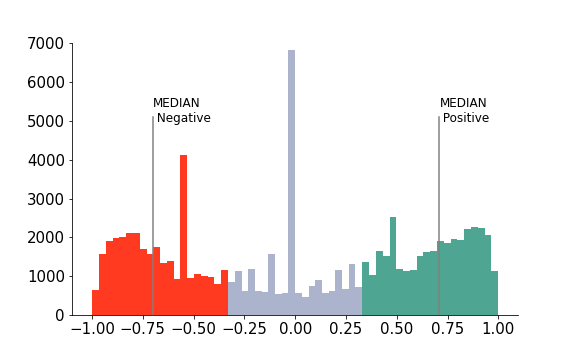
Fig.2.1 - Distribution of sentiment scores during the time period between March 2015 and January 2020 - a threshold of ± 0.33 is applied to the sentiment score to define the negative, neutral and positive categories
The distribution has a few interesting features.
- The are 27% of neutral quotations, 38% of positive and 35% of negative quotations
- The medians are almost symmetric, i.e. -0.700 on the negative side and 0.709 on the positive side for the ensemble of all quotations
The distribution looks equally distributed over positive and negative opinions, and no shift towards one side or the other can be demonstrated overall, [P<0.05]2. We can conclude there isn’t any tendency towards speaking more frequently in good or bads terms about gender equality questions. This conclusion might be a bit disappointing as we could expect that people have generally a positive opinion towards gender equality progress.
Looking especially at the positive and negative split of the dataset, it can be found that the medians have a similar strength, i.e. the negative quotations aren’t more negative than the positive ones. Overall, the underlying distributions of positive and negative quotations are similar [P<0.05]3.
For further analysis we will compare how sentiment scores differ from this reference state of equally distributed data amongst the three categories and same distribution inside the positive and negative ones.
How has Sentiment Evolved over time ?
A further look into the time distribution higlights how some periods are more favourable to negative or positive declarations on our topic.

Fig.2.2 - Time distribution of sentiment scores, per categories -- positive, neutral and negative. The period extends from March 2015 to January 2020.
Using thresholds on sentiment scores, quotes aer split on three categories –positive negative and neutral. An analysis over time shows that around the end of 2017 and early 2018 there is an increase in the amount of negative quotes. Meanwhile on the rest of the time period, positive sentiments are occuring more frequently than negative ones. The latter is reassuring with respect to the previous analysis as it shows that on normal time, the words voiced on feminist topics are mostly positive. Neutral quotes are also present but generally less than each of the other categories, as we have seen earlier. While this analysis is informative, the influence of the threshold value used for splitting is left unknown. As it could affect the number of quotes in a given category we suggest below a visualization of all sentiment scores over time.
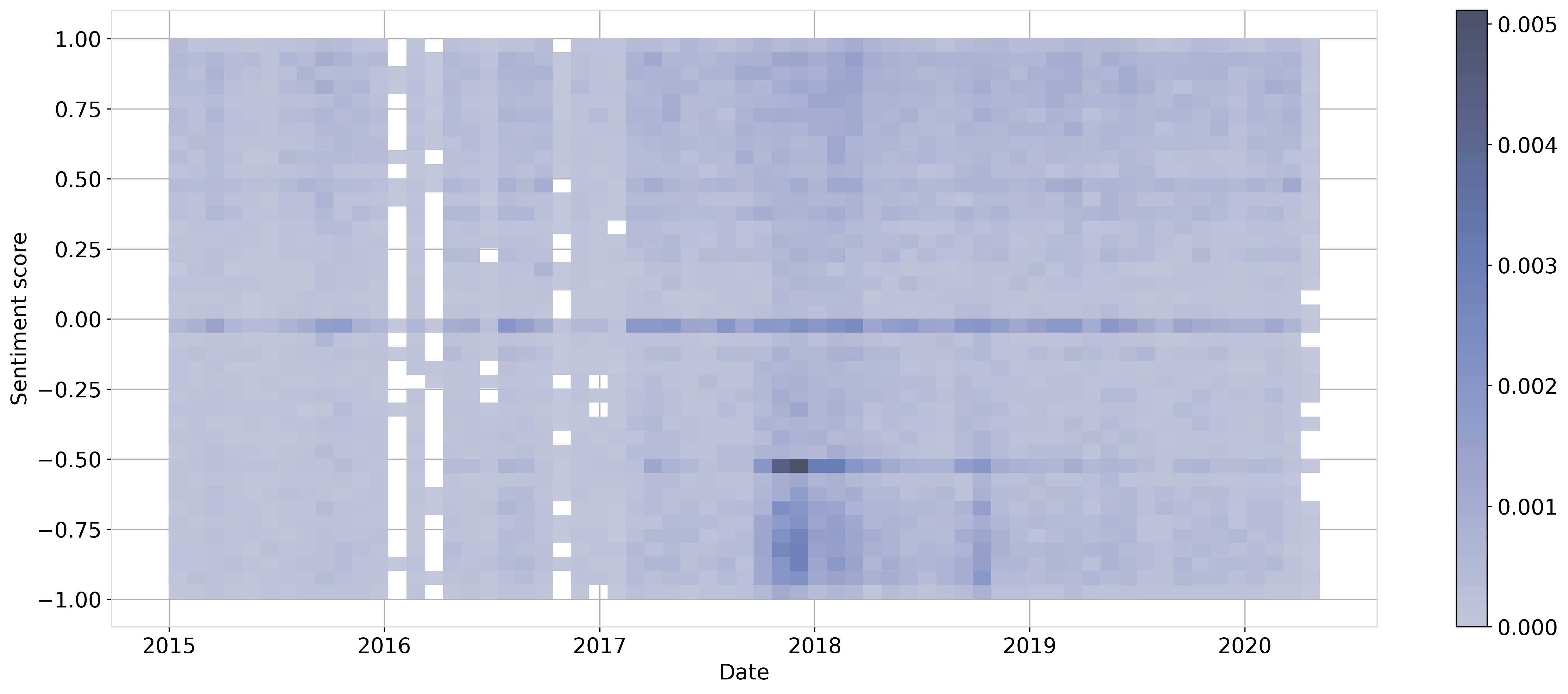
Fig.2.3 - Distribution of sentiment scores over time Each square represents a month (31 days), and sentiment scores are plotted by 0.05 interval where the color intensity represents the proportion the square bin represents with regards to all other square bins.
Aggregating the data this way could indicate that there is an increase in the number of quotes with negative sentiment around the end of 2017, but since the data isn’t normalized by time frame, it could be that there just were generally more quotes around end of 2017 than in other years, even if they were indeed mostly negative. At this point, to probe further our topic we look at the percentage of positive versus negative quotes, split by year.
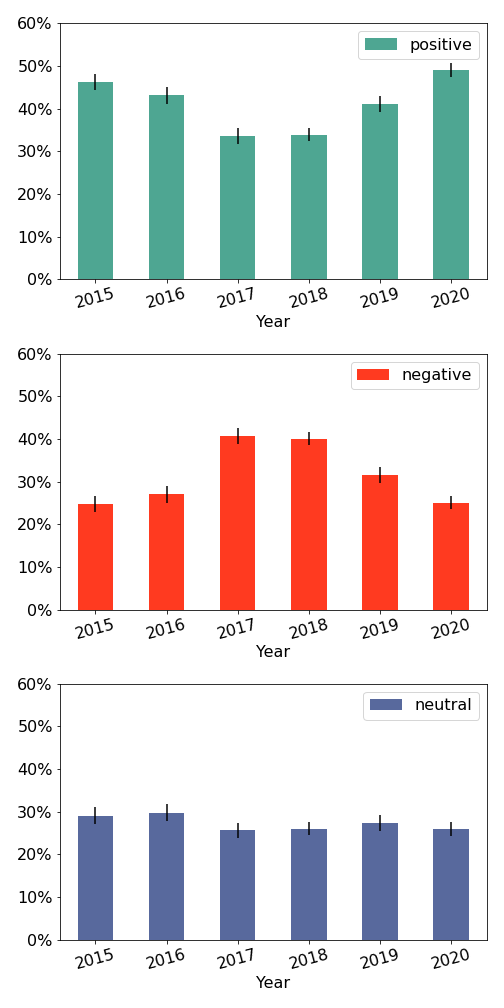
The histogram shows that in 2017 and 2018 the amount of negative quotes is higher than other years, while at the same time, the proportion of positive quotes decreases (the proportion of neutral quotes seems relatively stable). The confidence intervals ensure that we can make conclusions and that the variation from year to year are meaningful.
Together, the above results demonstrates that there is a change in 2017-2018 with respect to the other years. We will interrogate our dataset below to uncover possible reasons for this shift.
Are peaks in sentiment related to political or social events ?
In the last months of 2017 and early 2018 there is an increase in quotes with low sentiment scores. A dataset with 11,176 quotes corresponding to this period is created. The distribution of sentiment scores higlight the shift of occurences towards low values.
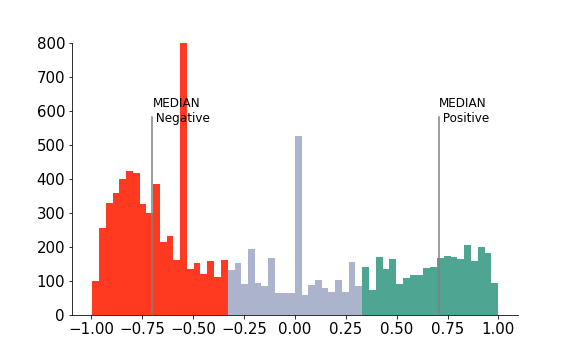
Fig.2.5 - Sentiment score distribution for quotations uttered between December 2017 and February 2018.
Precisely, the distribution is such that 50% of the quotes are negative for 26% of positive quotes. This represents an important shift with respect to the reference situation, defined above with 35% of negative quotes for 38% of positive quotes. Based on these observations, it seems like an event might have triggered negative topics related to women’s rights and gender equality in the public arena.
As a quick categorization, the keywords lists defined in the introduction of this datastory are used to determine the main topic of negative quotations voiced at the transition between 2017 and 2018. As a reminder, 10 categories were defined in the manual subtopic process. The results are unambiguous. Almost all quotes, ,go into the “sexual violences” category. This suggests there might have been a sexual harassment scandal around this time period, which would combine the negative aspect of the sentiment scores as well as the lexical field of sexual violences.

This is confirmed by the 5 most commons words occuring in the selected quotes.
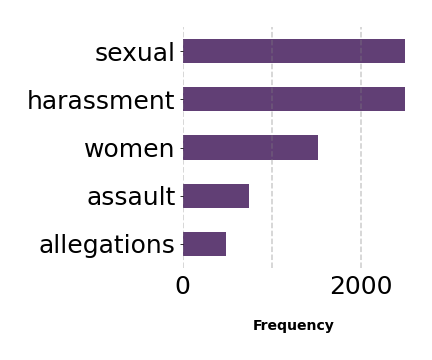
Fig.2.6 - Words frequency for the 5 most commons words. The quotations selected belong to the period between December 2017 to February 2018, and have a sentiment score below -0.35.
A few quotes are extracted from the dataset to illustrate what kind of sentences are found:
Quotes
I hope and expect that the Ethics Committee will fully investigate this troubling incident, as they should with any credible allegation of sexual harassment
To use terminology that has become familiar as the systemic reality of sexual harassment and assault has come more and more to light, Mark Schwahn’s behaviour over the duration of the filming of One Tree Hill was something of an open secret.
We stand together today to underscore this important day. As women, mothers, family physicians, and ministers responsible for improving the well-being of Indigenous communities, ending violence towards women is an issue that is close to our hearts. Violence against women and girls is simply not acceptable. Addressing it requires a united front
The quotes by themselves are not sufficient to understand what political or social event might explain the shift we observed. However, examining the 150th most frequent words, an interesting additional information can be exploited: the word “congress” occurs extremely often.
sexual harassment women assault allegations congress
A quick internet google search with this additional hint and the 5 most common words gives us the full story.
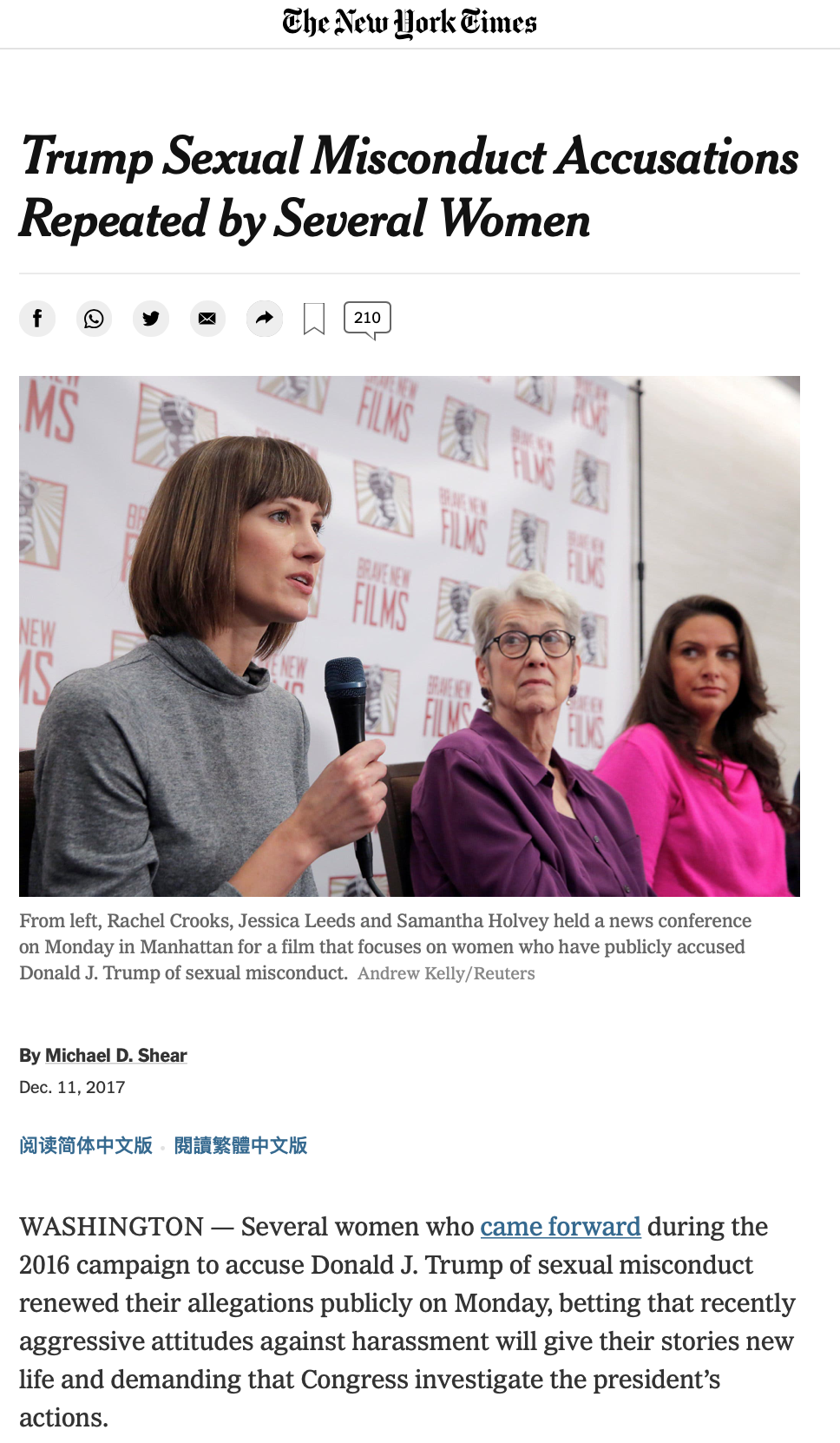
The quotations seem to be pointing at the Donald Trump sexual misconduct allegations that happened around the same period. An extract of quotes confirms that this topic is indeed (part of) what is happening.
Quotes
NEW: Women who have publicly accused President Trump of sexual harassment and assault will speak at a news conference, hosted by @bravenewfilms, Monday at 10:30 a.m. ET. The women are calling for an investigation by Congress of sexual misconduct by the president.
Unlike Donald Trump, Oprah’s never been accused of sexual harassment. She’s been sexually abused. Unlike Donald Trump, you know, this woman has faced poverty, she’s faced challenge. She has, she is relatable for real.
But generally speaking, if it’s a figure who’s in the Trump world [ who is in the news for sexual harassment ], typically it’s just ignored.
Conclusion
While these might not be entirely representative (see the comments about observational data), and that we can’t exclude the possibility of a confounder our method has a few interesting features.
Its makes good use of the additional data associated with the quotations –in this case the date– and additional tools to analyze the orientation of the sentences (positive or negative) to infer more meaning to quotes. The combination of Vader for sentiment with NLP allows to overcome some limitations of the sentiment analysis. In our case, the negative connotation is related to an event with a negative connotation, but the details of the event are infered by NLP.
Another interesting features is that this reverse design help determine what are the important events that shape feminist discussion in news articles. Indeed, only 100 quotes in the 5,099 quotes –from the negative quotes of the period of interest– mention Donald Trump directly. One interpretation could be that a lot of people prefer adressing the question in general terms, than directly mentionning him as a sexual offender due to his position of power. It could also be that this scandal lead to more discussions related to the topic of sexual violences in general. However in both cases, a direct investigation would have make it difficult to show the link due to low occurences of his name directly.
We suggest that the method developed here could be used to find other events that shape and orient discussion on gender equality topic. We also believe that additional datasets as history.com could help to highlight other candidate events for other peaks or shift in sentiment over time.
-
Vader is a tool that gives a sentiment score between -1 to 1, however this tool can’t precisely capture the sentiment of a quotes, for instance it won’t be able to recognize the irony, or the fact that someone with a positive comment is criticizing someone else negative opinion. Additionally, Flair and TextBlob were used on the entire dataset to compare with the scores Vader gave, using a simple threshold separating the scores into two positive and negative classes we observed that the tools all had the same label only 49% of the time. Vader agreed with TextBlob on 57% of the quotes, and Flair on 55% of the quotes. While the comparison method is quite simple, and might yield different results with different threshold, we can still say that tools like these that haven’t been trained on the same kind datasets will not always yield very meaningful results. ↩
-
A chi-square test with a null hyptothesis of equally distributed proportion can be found in the main notebook. ↩
-
A Mann-Whitney U test with a null hyptothesis of same underlying distribution for negative and positive quotes can be found in the main notebook. ↩